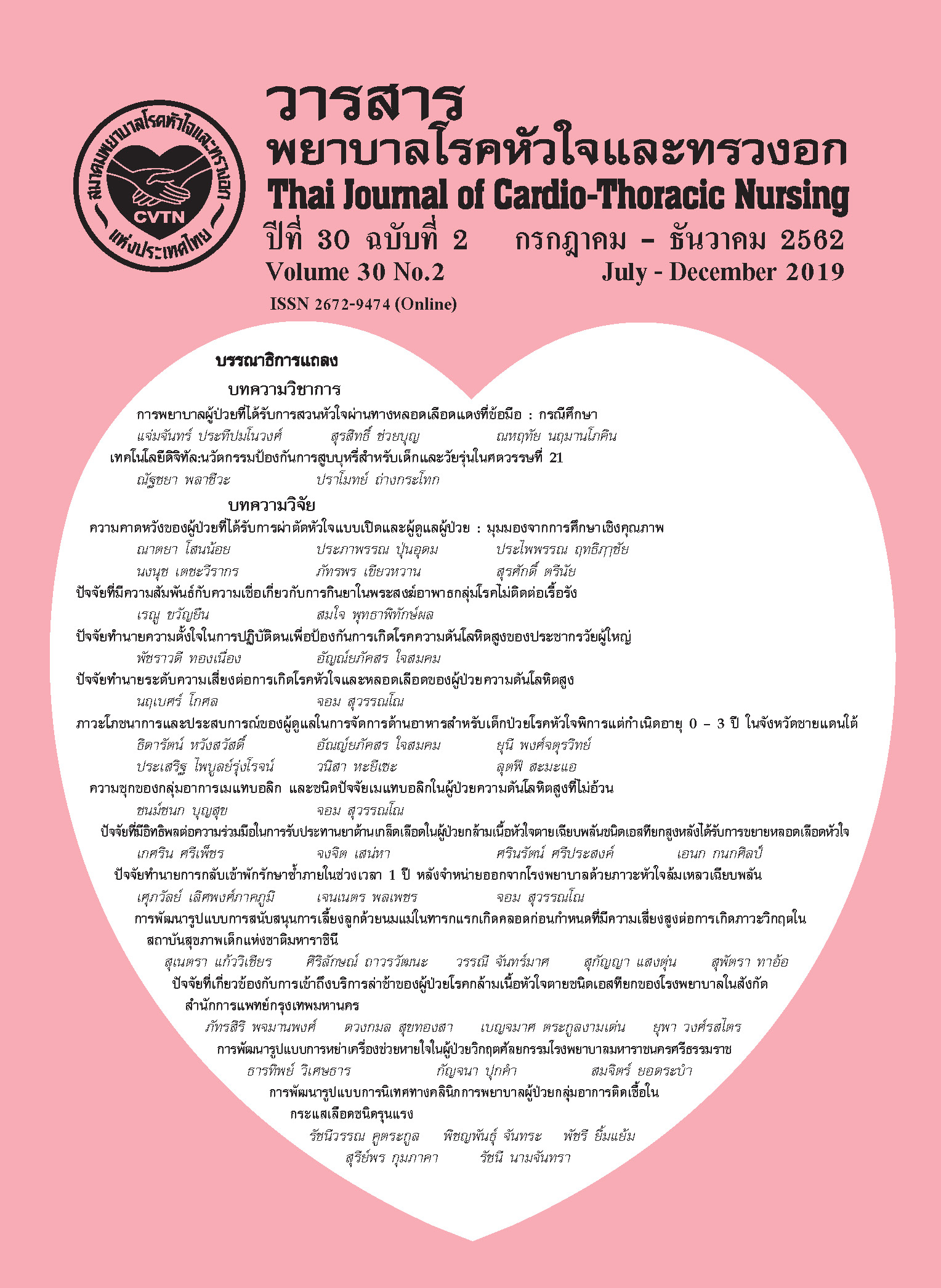ปัจจัยทำนายระดับความเสี่ยงต่อการเกิดโรคหัวใจและหลอดเลือดของผู้ป่วย ความดันโลหิตสูง
คำสำคัญ:
ปัจจัยเสี่ยงโรคหัวใจและหลอดเลือด, คะแนนความเสี่ยงฟรามิงแฮม, ความดันโลหิตสูงบทคัดย่อ
การวิจัยเชิงสำรวจแบบภาคตัดขวางนี้มีวัตถุประสงค์เพื่ออธิบายปัจจัยทำนายระดับความเสี่ยงต่อการ เกิดโรคหัวใจและหลอดเลือดในสิบปีข้างหน้าของผู้ป่วยความดันโลหิตสูง กลุ่มตัวอย่าง 492 ราย ซึ่งใช้บริการตรวจ รักษาในโรงพยาบาลส่งเสริมสุขภาพตำบลสี่แห่ง ในจังหวัดนครศรีธรรมราช ประเมินระดับความเสี่ยงโดยใช้ระบบคะแนนฟรามิงแฮม พิจารณาจากปัจจัยเสี่ยงหลักหกชนิด คือ อายุ ค่าความดันซิสทอลิก ค่าไขมันเอชดีแอล ค่าไขมัน คอเลสเตอรอล เบาหวาน และการสูบบุหรี่ จำแนกระดับความเสี่ยงออกเป็นต่ำ ปานกลาง และสูง รวมถึงประเมินปัจจัย เสี่ยงรอง ประกอบด้วย ค่าดัชนีมวลกาย ค่ารอบเอว ค่าไขมันไตรกลีเซอร์ไรด์ และค่าไขมันแอลดีแอล วิเคราะห์ โมเดลโลจิสติกโดยใช้ค่าอัตราส่วนความเสี่ยง และช่วงความเชื่อมั่นที่ร้อยละ 95
ผลพบว่า สองในห้ารายของกลุ่มตัวอย่างมีระดับความเสี่ยงสูง และสามในสี่รายของกลุ่มตัวอย่างมีความดันโลหิตสูงระดับ 1 ขึ้นไป เกินกว่าครึ่งหนึ่งเป็นผู้สูงอายุวัยกลาง มีระดับไขมันคอเลสเตอรอล ระดับน้ำตาลในเลือดสูงกว่าปกติ และมีระดับไขมันเอชดีแอลต่ำกว่าปกติ กลุ่มเสี่ยงสูงหนึ่งในสี่ราย (ร้อยละ 23.9) ยังสูบบุหรี่ วิเคราะห์โมเดลปัจจัยเดี่ยว พบว่าปัจจัยเสี่ยงหลักทุกชนิดสัมพันธ์กับระดับความเสี่ยงโรคหัวใจและหลอดเลือด โดยระดับความเสี่ยงเพิ่มขึ้นตามอายุ ค่าความดันซิสทอลิกสูง ค่าไขมันคอเลสเตอรอลสูง ค่าไขมันเอชดีแอลต่ำ โรคเบาหวาน และการสูบบุหรี่ ส่วนปัจจัยเสี่ยงรอง พบว่าผู้ที่อ้วนลงพุงมีความเสี่ยงสูงกว่าผู้ที่ไม่อ้วนลงพุง การวิเคราะห์โมเดลโลจิสติก พบว่ากลุ่มปัจจัยเสี่ยงหลักทำนายระดับความเสี่ยงสูงได้ร้อยละ 82.5 และเมื่อวิเคราะห์ร่วมกับกลุ่มปัจจัยเสี่ยงรอง พบค่าอิทธิพลการทำนายเพิ่มขึ้นเป็นร้อยละ 84.1
ข้อเสนอแนะ บุคลากรทางการแพทย์ควรพัฒนาโปรแกรมป้องกันการเกิดโรคหัวใจและหลอดเลือดในผู้ป่วยความดันโลหิตสูงโดยจัดการปัจจัยเสี่ยงหลักและปัจจัยเสี่ยงรอง รวมไปถึงการเพิ่มความตระหนักการรับรู้ความเสี่ยงในผู้ป่วยวัยผู้ใหญ่และไม่อ้วน
เอกสารอ้างอิง
World Health Organization (WHO). Global status report on noncommunicable diseases 2014. Geniva, Switzerland: WHO; 2014.
International Health Policy Program. Disability-adjust life year: DALY report 2013. Burden of Disease Research Program Thailand (BOD Thailand), Nonthaburi: Ministry of Public Health Thailand; 2013. (in Thai)
Bureua of Non Communicable Disease. Annual Report 2016 NCD. Bureua of Non Communicable Disease, Nonthaburi: Ministry of Public Health Thailand; 2016. (in Thai)
Chookheaw J, Suwanno J, Sameanphet T. Predictors of risk level of developing coronary heart disease in women with hypertension attending a rural community hospital. Journal of Nursing Division. 2013; 40(1) :39-56. (in Thai)
Kaewbangpood T, Suwanno J, Thiamwong L. Predictors of the ten-year risk level for developing coronary heart disease in rural older adults. Journal of Nursing and Health Science. 2015; 33(3): 174-84. (in Thai)
Chobanian AV, Bakris GL, Black HR, Cushman WC, Green LA, Izzo JL, et al. for the National Heart, Lung, and Blood Institute Joint National Committee on Prevention, Detection, Evaluation, and Treatment of High Blood Pressure; National High Blood Pressure Education Program Coordinating Committee. The Seventh Report of the Joint National Committee on Prevention, Detection, Evaluation, and Treatment of High Blood Pressure: the JNC 7 Report. JAMA. 2003; 289(19): 2560-72.
D'Agostino RB, Vasan RS, Pencina MJ, Wolf PA, Cobain M, Massaro JM, et al. General cardiovascular risk profile for use in primary care: the Framingham Heart study. Circulation. 2008; 117(6): 743-53.
Asia Pacific Cohort Studies Collaboration. Central obesity and risk of cardiovascular disease in the Asia Pacific Region. Asia Pac J Clin Nutr. 2006; 15(3): 287-92.
Ni Mhurchu C, Rodgers A, Pan WH, Gu DF, Woodward M, for the Asia Pacific Cohort Studies Collaboration. Body mass index and cardiovascular disease in the Asia-Pacific Region: an overview of 33 cohorts involving 310 000 participants. Int J Epidemiol. 2004; 33(4): 751-8.
Grundy SM, Becker D, Clark LT, Cooper RS, Denke MA, Howard JW, et al. for the National Cholesterol Education Program Expert Panel on Detection, Evaluation, and Treatment of High Blood Cholesterol in Adults (Adult Treatment Panel III). The Third Report of the National Cholesterol Education Program (NCEP) Expert Panel on Detection, Evaluation, and Treatment of High Blood Cholesterol in Adults (Adult Treatment Panel III) Final Report. Circulation. 2002; 106(25): 3143-421.
Damen JAAE, Hooft L, Schuit E, Debray TPA, Collins GS, Tzoulaki L, et al. Prediction models for cardiovascular disease risk in the general population: systematic review. BMJ. 2016; 353: i2416. doi:https://doi.org/10.1136/bmj.i2416.
Grundy SM, Pasternak R, Greenland P, Smith S, Fuster V. Assessment of cardiovascular risk by use of multiple-risk-factor assessment equations: a Statement for Healthcare Professionals from the American Heart Association and the American College of Cardiology. Circulation. 1999; 100: 1481-92.
Conroy RM, Pyörälä K, Fitzgerald AP, Sans S, Menotti A, De Backer G, et al. on behalf of the SCORE project group. Estimation of ten-year risk of fatal cardiovascular disease in Europe: the SCORE project. Eur Heart J. 2003; 24(11): 987-1003.
Mendis S, Lindholm LH, Mancia G, Whitworth J, Alderman M, Lim S, et al. World Health Organization (WHO) and International Society of Hypertension (ISH) risk prediction charts: assessment of cardiovascular risk for prevention and control of cardiovascular disease in low and middle-income countries. J Hypertens. 2007; 25(8): 1578-82.
Selvarajah S, Kaur G, Haniff J, Cheong KC, Hiong TG, van der Graaf Y, et al. Comparison of the Framingham Risk Score, SCORE and WHO/ISH cardiovascular risk prediction model in an Asian population. Int J Cardiol. 2014; 176(1): 211-8.
Neuman B. The Neuman Systems Model (3rd ed.). Norwalk, CT: Appleton & Lange; 1995.
Brandes RP. Endothelial dysfunction and hypertension. Hypertension. 2014; 64(5): 924-8.
Marinou K, Tousoulis D, Antonopoulos AS, Stafanadi E, Stafanadis C. Obesity and cardiovascular disease: from pathophysiology to risk stratification. Int J Cardiol. 2010; 138(1): 3-8.
Yamane T. Statistics: An introductory analysis. NY: New York Harper and Row; 1973.
Zhou M, Offer A, Yang G, Smith M, Hui G, Whitlock G, et.al. Body mass index, blood pressure, and mortality from stroke: a nationally representative prospective study of 212,000 Chinese men. Stroke. 2008; 39(3): 753-9.
Lavie CJ, Milani RV, Ventura HC. Obesity and cardiovascular disease risk factor, paradox, and impact of weight loss. J Am Coll Cardiol. 2009; 53(21): 1925-32.
RAMA-EGAT Cohort Study. RAMA-EGAT Heart Score. [cited 2019, August 16]. Available from: https://med.mahidol.ac.th/cvmc/th/event/ramaegatheartscore (in Thai).
ดาวน์โหลด
เผยแพร่แล้ว
รูปแบบการอ้างอิง
ฉบับ
ประเภทบทความ
สัญญาอนุญาต
บทความนี้ยังไม่เคยตีพิมพ์หรืออยู่ในระหว่างส่งไปตีพิมพ์ในวารสารอื่น ๆ มาก่อน และกองบรรณาธิการขอสงวนสิทธิ์ในการตรวจทาน และแก้ไขต้นฉบับตามเกณฑ์ของวารสาร ในกรณีที่เรื่องของท่านได้ได้รับการตีพิมพ์ในวารสารฉบับนี้ถือว่าเป็น ลิขสิทธิ์ของวารสารพยาบาลโรคหัวใจและทรวงอก






